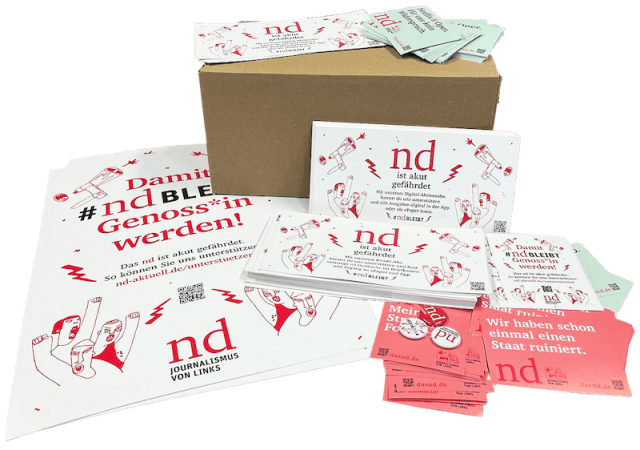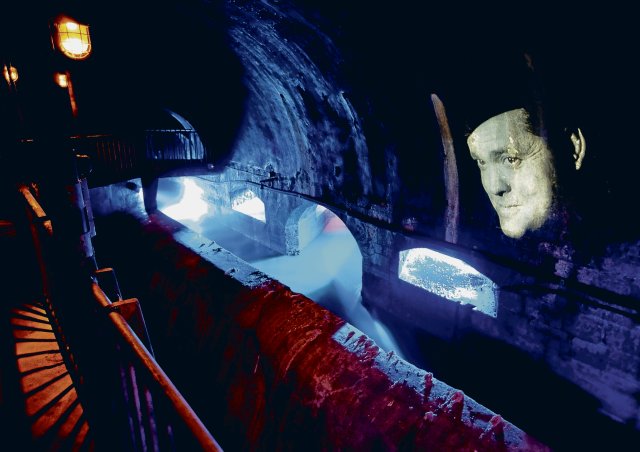The thriller “The Third Man” with Orson Welles in the lead role is set in post-war Vienna. The Allies had divided the city among themselves. Espionage flourished, as did the black market.
Photo: Michael Marek
The old town of Vienna, the writing in red letters cannot be missed: “3rd Man Tour”. We are standing at the central Girardi Park. On the left the Vienna police station, on the right the famous Secession. Around us: Art Nouveau building, behind the baroque Karlskirche. A horse-drawn carriage drives past the memorial for the homosexual victims of National Socialism. And at our feet, deep in secret, lies the Vienna River with its history.
Below the upper world there is a 2,500 kilometer long canal system. “The most important hygiene center in the city,” says tour guide Sebastian, who is actually an actor and doesn’t want to give his full name. Today he will lead a group of 15 people through a labyrinth of brick passages and tunnels – to where the city’s sewers converge. Before that he shows an illustration from the 19th century. You can see: the river is pretty blue! Why? “At that time, all the untreated wastewater flowed directly into the river,” explains Sebastian. There were tanneries and other polluting industries outside the city walls. As a result, the river was a colorful and smelly sewer. »From which beautiful gas bubbles always rose, which the children loved to light. A guaranteed children’s game from back then.« Fireworks for the poor.
From the upper world into the depths
Before going down, everyone is given a helmet, a hair scarf and a lamp; For some you can see the excitement, for others it even seems like a test of courage in view of what awaits us below: sewers, stinking smells, maybe rats? Then it’s off to the original filming location of “The Third Man”: an octagonal entrance with star-shaped, pointed, triangular stainless steel plates that squeak open and reveal a steep spiral staircase – seven meters deep underground. From here, Orson Welles once fled as the unscrupulous black market crook Harry Lime down into the underground sewage system. The star lid is still there. Just like in the movie.

Orson Welles in “The Third Man”
Photo: Imago/SIMI ALL
Vienna after the end of the Second World War: The half-destroyed city, like Berlin, is divided into sectors among the four Allies. The black market is flourishing, hunger and desperation are spreading. Joseph Cotten plays the American Holly Martins. The author of cheap western novels is invited to Vienna by his old friend Harry Lime, played by Orson Welles.
This is how one of the most famous post-war films from 1949 begins. “The Third Man”, the drama about corruption, betrayal, murder and spurned love, is not only considered a black and white classic. The British Film Institute named it the best British film of all time in 1999. High-contrast lighting scenes, sophisticated light-and-shadow effects in stairwells and the showdown chase through the Vienna sewers made it a masterpiece of film noir.
Even back then, Orson Welles was known for his airs and graces. The Hollywood star had already won an Oscar with “Citizen Kane”. There is evidence that Welles had himself doubled for some scenes and that some canal scenes were recreated and filmed in the London studio. The director of the radio adaptation of “War of the Worlds” is said to have been grumpy when it came to acting down here on the canal set. “You had to clean the walls with soap before it even went down,” says Sebastian. Welles even had perfume sprayed to work in the underworld. Truth or fiction?
Film history in the Vienna underground
We continue along clingy brick walls to inspect the original locations. In the dim light of the helmet lights we walk over damp metal grates. Water drips from the vault, and you can hear a diffuse rushing of water in the background. The canal smells surprisingly bearable. In the sewer system’s huge, 20 meter long and six meter high overflow chamber, a short film best-of is projected onto the wall. Unmistakable despite the partial shade: Welles’s face. “He himself was offered $100,000 or a share of the profits. What did he decide on?” the guide asks the group. Of course, for the dollars! Cash is king. Welles was chronically in need of money, always lived beyond his means and didn’t believe in the film’s success.
The post-war thriller was initially not met with much love among the Viennese either; It was only shown in a few cinemas and also received bad reviews in the newspapers. Over the years, however, that has changed, explains Sebastian. Nowadays, tourists come, but also Viennese history and film buffs who are fascinated by what you can’t see: the city beneath the city, to which you usually don’t have access.
nd.DieWoche – our weekly newsletter

With our weekly newsletter nd.DieWoche look at the most important topics of the week and read them Highlights our Saturday edition on Friday. Get your free subscription here.
While the guide humorously points out many production details, we continue through narrow corridors, a labyrinth of tunnels, dimly lit avenues with round vaulted ceilings and alleys that are barely human-high. It echoes and gurgles, drips and moulders in the darkness of the underworld. As early as 1739, Vienna was the first European capital to have a canal network. The Vienna River, which engineers banished beneath the city at the end of the 19th century, rushes unmolested. There is a sweet smell at the Manner factory. Because chocolate is produced for the Neapolitan slices, explains Sebastian. This is also why the wastewater broth here would look dark, like bittersweet.
The Vienna canal network
Currently, 200 employees of the municipal company Wien-Kanal take care of the maintenance and functionality of the sewage system. Around 1900 the social situation in Vienna was catastrophic. Homeless people lived in the sewers down here. I want to know what the unfortunate people lived on. From everything that fell into the sink or toilet of the residents of the upper city: necklaces, brooches or earrings that were searched for and collected by the underground, says Sebastian. Most of it was scrap metal, some scrap that was resold back then.
When it rains, when the capacity of the sewage treatment plants is not sufficient, the wastewater flows over the overflow weirs and thunders out of recesses in the side walls into central tunnels. In less than two minutes, the water level could rise to such an extent that it would be impossible to walk here, explains a canal worker who accompanies the entourage. Two rules are therefore essential for survival: Never climb into the canals when it is raining. And leave the underground sewage system immediately if it rains.
At the end of the tour, zither music can be heard in the tunnel corridors: Heurigen songs, i.e. music that is played in Viennese bars while serving wine. Anton Karas had composed it for “The Third Man”. »This is also a fairy tale story. Because Karas was a working class boy from the 20th district. “He was basically paired up with the director Carol Reed,” Sebastian reports. And Reed had a feel for Karas’ vibrating strings.
From the underworld back to the daylight
Hardly anyone outside of Austria knew about the zither; it was only known in southern Germany and Switzerland. But otherwise the instrument, sound and folk music styles were completely unknown. It is said that director Reed happened to hear Karas playing in a bar and immediately wanted to hire him for the film and bring him to London. But Karas always talked about being homesick and afraid of flying. And what did the producers do? “Bought a fur coat on the black market for Karas’ wife and then took the plane to London.” There they worked from morning to evening, and Karas became world famous with the soundtrack. He overcame his fear of flying and had a hit in the USA and Great Britain. The Viennese went on a two-year tour around the world.
The ending of the film is known. Orson Welles with his diabolical charm of evil dives into the underground labyrinth of the Vienna sewers, a hunt begins through extensive shafts and tunnels, over steps and ladders, with the international police of the occupying powers behind him. Finally he is caught and shot. For us it goes back up after 60 minutes. Fresh air, blue sky. Sebastian recommends Sachertorte with whipped cream in the coffee house.
#ndstays – Get active and order a promotional package

Regardless of whether it is pubs, cafés, festivals or other meeting places – we want to become more visible and reach everyone who values independent journalism with an attitude. We have put together a campaign package with stickers, flyers, posters and buttons that you can use to get active and support your newspaper.
To the promotional package
link sbobet link sbobet link sbobet akun demo slot
